Plantains Nutrition facts
Plantains, also known as plátanos, are closely related cultivars of fruit or dessert banana. In general, they are treated as vegetables in the kitchen much like fellow tropical produces such as potatoes, taro, breadfruit, yam, sweet-potatoes, etc. Indeed, plátano has been one of the staple sources of carbohydrates for larger populations in Asia, Oceania, Africa, and Central America for centuries served in main meals.
As in the bananas, plantain too belongs to the Musaceae family. In their natural habitat, plátano was thought to have developed by hybridization of two wild species of Musaceae, Musa acuminata Colla (AA) and M. balbisiana Colla (BB), and consist of chromosomal triploid AAB genome.
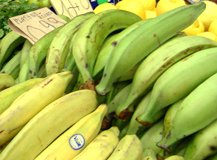
|
|
| Plantain. Photo: Shiv (flickr.com) | Raw as well as ripe plantains in a supermarket. Photo courtesy: Luigi Guarino |
Plantain is quite different from dessert banana, being taller and larger and more drought tolerant. It is a perennial herbaceous plant that develops from the underground rhizome. Like bananas, it too flourishes well under tropical moisture-rich, humid, low-lying farmlands.
At maturity, the rhizome gives rise to a flower (inflorescence) that is carried up along its smooth, elongated, unbranched stem, piercing through the center of the pseudo-stem, finally emerging out at the top in between its leafy clusters. The flower eventually develops into a bunch, consisting of 3 to 20 hands, with each group holding at least 5-10 fingers (fruits).
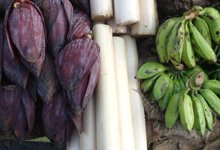
|
| Plantain (right) with Inflorescence and tender banana stem in a market. |
Raw green plantains can only be eaten after cooking. Each fruit measures about 3 to 10 inches or more in length depending upon the cultivar type. They tend to have coarser external features with prominent edges and a flat surface, unlike the smooth, rounded contour of dessert bananas. The flesh inside is rich in starch, with tiny edible black seeds concentrated at its core. The ripening process, however, enhances flavor and sweetness since much of its starch converts to sugar, similar to the case of fruit bananas but to a lesser extent.
Plantain flower (inflorescence), as well as its central stem (true-stem), are eaten in various kinds of recipes in South-Asian regions.
Health benefits of Plantains
Plantain relatively has more calories weight for weight than that in the table bananas. 100 g plantain holds about 122 calories, while dessert banana has only 89 calories. Indeed, they are very reliable sources of starch and energy; ensuring food security for millions of inhabitants worldwide.
It contains 2.3 g of dietary fiber per 100 g (6% of DRA per 100 g). The adequate amount of dietary fiber in the food helps regular bowel movements, thereby reducing constipation problems.
Fresh plátanos have more vitamin-C than bananas. 100 g provides 18.4 mg or 31% of the daily required levels of this vitamin. Consumption of foods rich in vitamin-C helps the body develop resistance against infectious agents and scavenge harmful oxygen-free radicals. However, boiling and cooking destroys much of this vitamin in plantains.
Plantains carry more vitamin A than bananas. 100 g fresh ripe plantains contain 1127 IU or 37.5% of the daily required levels of this vitamin. Besides being a powerful antioxidant, vitamin A plays a vital role in the visual cycle, maintaining healthy mucosa, and enhancing skin complexion.
As in bananas, they too are rich sources of B-complex vitamins, particularly high in vitamin B6 (pyridoxine). Pyridoxine is an important B-complex vitamin that has a beneficial role in the treatment of neuritis, anemia, and to decrease homocysteine (one of the causative factors for coronary artery disease (CHD) and stroke episodes) levels in the body. Also, the fruit contains moderate levels of folates, niacin, riboflavin, and thiamin.
They also provide adequate levels of minerals such as iron, magnesium, and phosphorous. Magnesium is essential for bone strengthening and has a cardiac-protective role as well.
Fresh plantains have more potassium than bananas. 100 g fruit provides 499 mg of potassium (358 mg per 100 g for bananas). Potassium is an important component of cells and body fluids that helps control heart rate and blood pressure, countering the adverse effects of sodium.
| Principle | Nutrient Value | Percent of RDA |
|---|---|---|
| Energy | 122 Kcal | 6% |
| Carbohydrates | 31.89 g | 24.5% |
| Protein | 1.30 g | 2% |
| Total Fat | 0.37g | 2% |
| Cholesterol | 0 mg | 0% |
| Dietary Fiber | 2.30 g | 6% |
| Vitamins | ||
| Folates | 22 µg | 5.5% |
| Niacin | 0.686 mg | 4% |
| Pyridoxine | 0.299 mg | 23% |
| Riboflavin | 0.054 mg | 4% |
| Thiamin | 0.052 mg | 4% |
| Vitamin A | 1127 IU | 37.5% |
| Vitamin-C | 18.4 mg | 31% |
| Vitamin-E | 0.14 mg | 1% |
| Vitamin K | 0.7 µg | 1% |
| Electrolytes | ||
| Sodium | 4 mg | <1% |
| Potassium | 499 mg | 10.6% |
| Minerals | ||
| Calcium | 3 mg | <0.5% |
| Iron | 0.60 mg | 7.5% |
| Magnesium | 37 mg | 9% |
| Phosphorus | 34 mg | 5% |
| Zinc | 0.14 mg | 1% |
Selection and storage
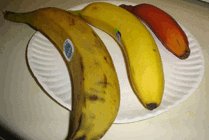
|
| Plantain (left) and banana. Photo courtesy: satanoid. |
Plantains of all varieties can be readily available in the USA supermarkets all around the year. At maturity, they are generally harvested unripely and right away carried to the market for sale.
Look for firm, mature, deep green, well-formed plantains that feel heavy in hand. Do not buy overripe, damaged, split fruits, as they stay poor. Once at home, store them open at room temperature for up to 4-5 days.
Once ripe, plantains too, like bananas, are very fragile and show signs of decay in a short time span.
Preparation and Serving methods
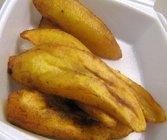
|
| Fried plantains. Photo courtesy: Purdman1. |
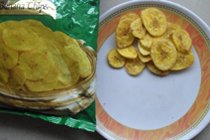 |
| Plantain chips (vaazhakka upperi)-India |
Plantains are inedible raw and should be eaten only after cooking.
To prepare, just wash the raw fruit in cold water and mop dry using a paper cloth. Using a paring knife, trim either end. Then, cut the fruit into short lengths, split the skin superficially along the ridge, and peel the skin gently away from the flesh to get firm flesh inside. Oftentimes, the whole fruit may be barbecued with its skin. Otherwise, its peeled flesh may be cut into thin slices, and chunks treated much like potatoes in many traditional African and West-Indian cuisine.
Plátano can be delicious once cooked and usually served in main dishes as the chief carbohydrate source in many parts of the tropical regions.
Here are some serving tips:
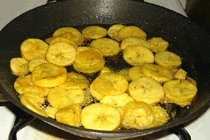 |
| Tostones are other Caribbean specials. Photo courtesy: John Stephen. |
Plantains make delicious savory recipes, used in place of potatoes in grills, mashed, bake, or fries.
In South-Indian Kerala state, plantain chips (vaazhakka upperi) seasoned with salt and pepper, is a popular snack. Tostones (twice-fried plátano), prepared in a similar way, are again enjoyed as snacks in the Caribbean and Latin Americas.
Its flower head (inflorescence) and interior icicle-white, tender stem (vazhai thandu in Malayalam) are eaten in various kinds of recipes in South-Asian regions.
Sopa de plátano is a popular Caribbean soup preparation that used green plátanos, garlic, cilantro, and cheese.
Mashed plantain served with fried onions is a national breakfast dish of the Dominican Republic. Mashed plátanos are served with rice, eggs, beans, poultry, fish, etc., in these regions.
Safety profile
Being a close member of bananas, plantains also often can be a cause for local and systemic allergic reactions in some sensitive individuals. The fruit may elicit urticaria and may cause potentially severe gastrointestinal symptoms like nausea, vomiting, and diarrhea.
"Oral allergy syndrome" is a condition in which eating banana family foods may cause swelling and itching of the mouth or throat within hours.
Another kind of allergic reaction may be related to plant latex. (Medical disclaimer).
You may also like to read ≻≻-
≺≺ Banana fruit nutrition facts and health benefits.
≺≺ Back to Vegetables from Plantains nutrition. Visit here for an impressive list of vegetables with complete illustrations of their nutrition facts and health benefits.
≺≺-Back to Home page.
Further referances:
Musa species-Banana and plantains.
USDA - Nutrient Database for Standard Reference.